人教版高中英语必修4:Body Language
- 格式:ppt
- 大小:20.80 MB
- 文档页数:30
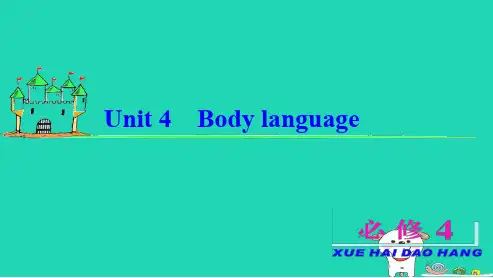
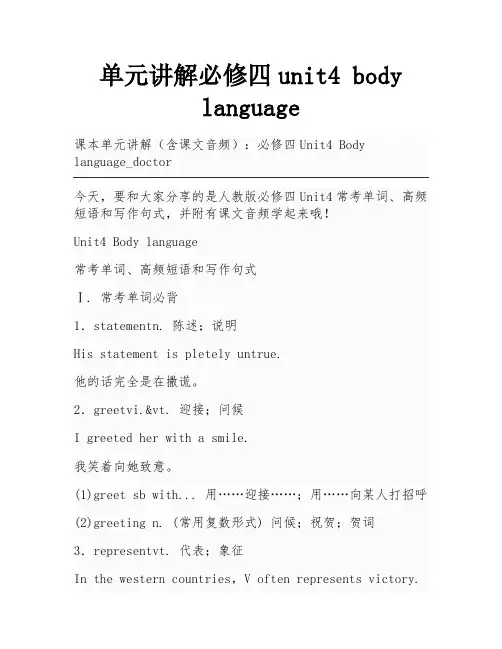
单元讲解必修四unit4 bodylanguage课本单元讲解(含课文音频):必修四Unit4 Body language_doctor今天,要和大家分享的是人教版必修四Unit4常考单词、高频短语和写作句式,并附有课文音频学起来哦!Unit4 Body language常考单词、高频短语和写作句式Ⅰ. 常考单词必背1.statementn. 陈述;说明His statement is pletely untrue.他的话完全是在撒谎。
2.greetvi.&vt. 迎接;问候I greeted her with a smile.我笑着向她致意。
(1)greet sb with... 用……迎接……;用……向某人打招呼(2)greeting n. (常用复数形式) 问候;祝贺;贺词3.representvt. 代表;象征In the western countries,V often represents victory.在西方国家,V常象征着胜利。
He represented himself as a doctor.他自称是一个医生。
[快速闪记](1)represent sth to sb 向某人说明某事,向某人传达某事represent...as... 把……描绘成……represent oneself as/to be... 自称是……(2)representative n. 代表4.curiousadj. 好奇的The children were curious to know what was happening over there.孩子们很想知道那边发生了什么事。
[快速闪记](1)be curious about 对(某事物)感到好奇be curious to do... 很想做某事;渴望做某事(2)curiously adv. 好奇地5.approachvt..&vi.接近;靠近;走近 n. 接近;方法;途径As summer approached,the weather became hotter and hotter.随着夏天的临近,天气越来越热。
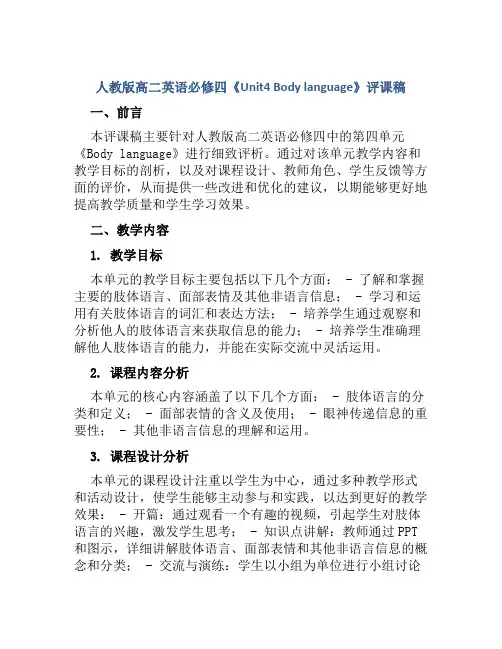
人教版高二英语必修四《Unit4 Body language》评课稿一、前言本评课稿主要针对人教版高二英语必修四中的第四单元《Body language》进行细致评析。
通过对该单元教学内容和教学目标的剖析,以及对课程设计、教师角色、学生反馈等方面的评价,从而提供一些改进和优化的建议,以期能够更好地提高教学质量和学生学习效果。
二、教学内容1. 教学目标本单元的教学目标主要包括以下几个方面: - 了解和掌握主要的肢体语言、面部表情及其他非语言信息; - 学习和运用有关肢体语言的词汇和表达方法; - 培养学生通过观察和分析他人的肢体语言来获取信息的能力; - 培养学生准确理解他人肢体语言的能力,并能在实际交流中灵活运用。
2. 课程内容分析本单元的核心内容涵盖了以下几个方面: - 肢体语言的分类和定义; - 面部表情的含义及使用; - 眼神传递信息的重要性; - 其他非语言信息的理解和运用。
3. 课程设计分析本单元的课程设计注重以学生为中心,通过多种教学形式和活动设计,使学生能够主动参与和实践,以达到更好的教学效果: - 开篇:通过观看一个有趣的视频,引起学生对肢体语言的兴趣,激发学生思考; - 知识点讲解:教师通过PPT 和图示,详细讲解肢体语言、面部表情和其他非语言信息的概念和分类; - 交流与演练:学生以小组为单位进行小组讨论和角色扮演,运用所学的肢体语言及表情,进行交流和演练;- 学习资源拓展:提供相关阅读材料和视频资源,供学生自主学习和拓展。
三、教师角色分析1. 课前准备教师在教学前应充分准备,并具备深入了解和掌握本单元内容的能力,以便能够传递给学生有效的知识和技能。
2. 授课过程中在正式授课过程中,教师应发挥引导者和组织者的作用,注重学生的主体性和参与性,通过引发学生思考、提问、讨论等方式,激发学生的学习兴趣和积极性。
同时,教师还应在学生实践活动中进行指导和点评,及时帮助学生纠正错误。
3. 课后总结教师应对本节课的教学效果进行总结和评估,及时调整和改进教学策略,为后续的教学提供参考。
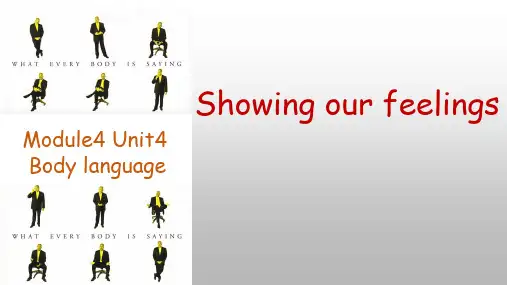
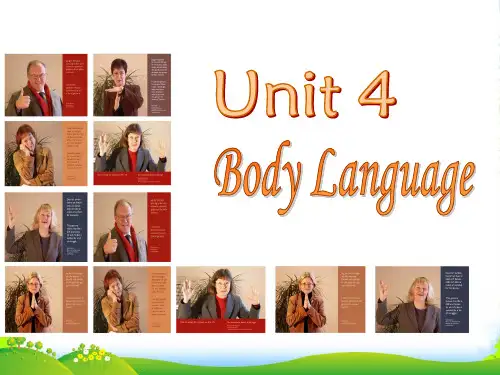

SectionⅣWriting——描述肢体语言【文体感知】肢体语言描述也是新课程标准中的写作要求之一,是对某一肢体语言进行描述和说明,通过一个人的手势、肢体动作我们可以了解到他的思想意识、情绪变化等。
其基本框架如下:首先,介绍常见的某些肢体语言,引入话题。
其次,说明这些肢体语言在不同文化中的含义。
最后,表达期望。
【增分佳句】夺人眼球开头句1.I'm more than delighted to hear from you.很高兴收到你的来信。
2.Now I'm writing to tell you something about body language.现在我正写信告诉你有关肢体语言的一些事情。
亮点出彩篇中句1.People from different cultures may misunderstand the gestures they use.有着不同文化背景的人们对彼此的手势很有可能产生误会。
2.Body language is a way of communication,but not everybody can use the same body language to communicate with others.肢体语言是与人交流的一种方式,但并非所有的人都可以用同一种肢体语言与他人交流。
3.If you want to go out to travel,it is very important for you to figure out the body language there.如果你要外出旅游,了解当地的肢体语言是非常重要的。
4.When your friend is sad,a smile may be more useful than words.当你的朋友伤心的时候,一个微笑或许比语言更有用。
5.Body language is the quiet,secret and most powerful language of all!肢体语言是所有语言中安静、神秘、最强有力的语言!韵味无穷结尾句1.By learning body language we can broaden our mental horizons and increase our knowledge in various fields.通过学肢体语言我们能够开阔我们的精神视野,增加我们在各领域的知识。
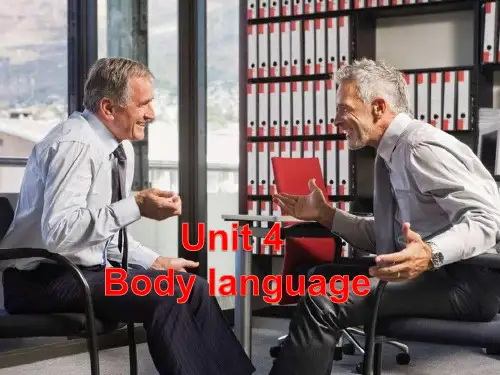
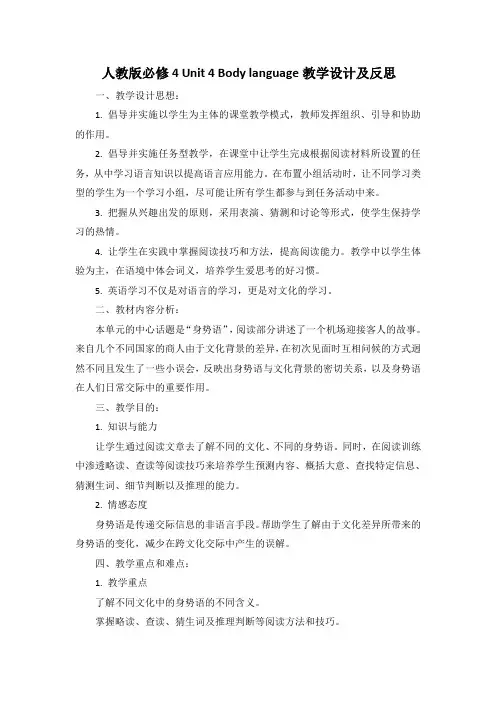
人教版必修4 Unit 4 Body language教学设计及反思一、教学设计思想:1. 倡导并实施以学生为主体的课堂教学模式,教师发挥组织、引导和协助的作用。
2. 倡导并实施任务型教学,在课堂中让学生完成根据阅读材料所设置的任务,从中学习语言知识以提高语言应用能力。
在布置小组活动时,让不同学习类型的学生为一个学习小组,尽可能让所有学生都参与到任务活动中来。
3. 把握从兴趣出发的原则,采用表演、猜测和讨论等形式,使学生保持学习的热情。
4. 让学生在实践中掌握阅读技巧和方法,提高阅读能力。
教学中以学生体验为主,在语境中体会词义,培养学生爱思考的好习惯。
5. 英语学习不仅是对语言的学习,更是对文化的学习。
二、教材内容分析:本单元的中心话题是“身势语”,阅读部分讲述了一个机场迎接客人的故事。
来自几个不同国家的商人由于文化背景的差异,在初次见面时互相问候的方式迥然不同且发生了一些小误会,反映出身势语与文化背景的密切关系,以及身势语在人们日常交际中的重要作用。
三、教学目的:1. 知识与能力让学生通过阅读文章去了解不同的文化、不同的身势语。
同时,在阅读训练中渗透略读、查读等阅读技巧来培养学生预测内容、概括大意、查找特定信息、猜测生词、细节判断以及推理的能力。
2. 情感态度身势语是传递交际信息的非语言手段。
帮助学生了解由于文化差异所带来的身势语的变化,减少在跨文化交际中产生的误解。
四、教学重点和难点:1. 教学重点了解不同文化中的身势语的不同含义。
掌握略读、查读、猜生词及推理判断等阅读方法和技巧。
2. 教学难点对文章内容进行推理判断的能力及在实践中运用阅读技巧的能力。
五、教学方法:任务型教学问答讨论六、学法指导:教师在教学中渗透一些阅读方法,如略读和查读等。
七、教学步骤:Step 1 LeadinProvide some students with several pieces of paper on which some directions are written. For example:1. Show gestures for“Well done / OK / Be quiet / Stop”.2. Show expressions for being “happy / sad / frightened / angry / proud”.The students are asked to make a demonstration of those actions with body language.【设计说明】这项任务旨在通过学生的参与并以游戏的形式来展现和导入本单元的主题——Body language,不仅能提高学生对所学内容的兴趣,充分起到了热身的作用,而且能使学生通过对旧知识的回顾从而自然过渡到对新知识的学习上来。
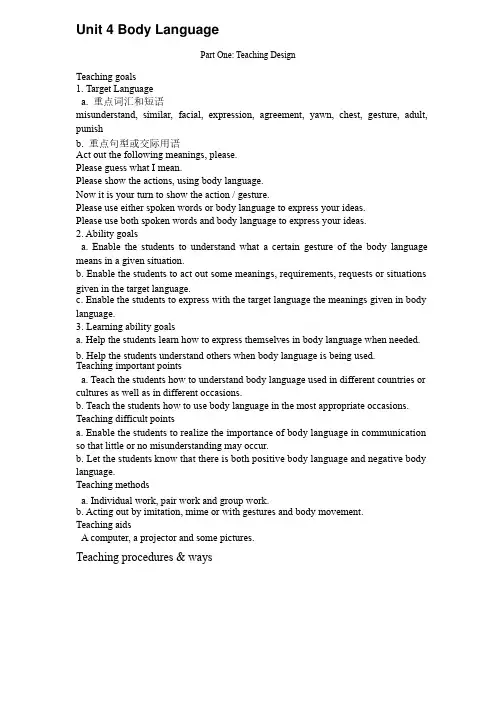
Unit 4 Body LanguagePart One: Teaching DesignTeaching goals1. Target Languagea. 重点词汇和短语重点词汇和短语misunderstand, similar, facial, expression, agreement, yawn, chest, gesture, adult, punishb. 重点句型或交际用语重点句型或交际用语Act out the following meanings, please.Please guess what I mean.Please show the actions, using body language.Now it is your turn to show the action / gesture.Please use either spoken words or body language to express your ideas.Please use both spoken words and body language to express your ideas.2. Ability goalsa. Enable the students to understand what a certain gesture of the body language means in a given situation.b. Enable the students to act out some meanings, requirements, requests or situations given in the target language.c. Enable the students to express with the target language the meanings given in body language.3. Learning ability goalsa. Help the students learn how to express themselves in body language when needed.b. Help the students understand others when body language is being used.Teaching important pointsa. Teach the students how to understand body language used in different countries or cultures as well as in different occasions.b. Teach the students how to use body language in the most appropriate occasions. Teaching difficult pointsa. Enable the students to realize the importance of body language in communication so that little or no misunderstanding may occur.b. Let the students know that there is both positive body language and negative body language.Teaching methodsa. Individual work, pair work and group work.b. Acting out by imitation, mime or with gestures and body movement.Teaching aidsA computer, a projector and some pictures.Teaching procedures & waysThe first period reading(COMMUNICATION: NO PROBLEM?)AimsTo help students develop their reading ability.To help students learn about body language.ProceduresI. Warming upWarming up by actingLook at the list of interpretation on the right side of the chart. Perform the action or the nonverbal behaviour on the left side.Examples Of Body LanguageWarming up by defining—What is body language?II. Pre-reading1. Looking and sayingLook at the man in the picture below. What does he say to you by his body language?Basically, how the ...... do I know? Or, I don’t know nothin! The shoulders are hunched and the hands are open signifying a big question mark.2. Talking and sharingBody language is the quiet, secret and most powerful language of all!According to experts, our non-verbal language communicates about 50% of what we really mean (voice tonality contributes 38%) while words themselves contribute a mere 7%.Our bodies send out messages constantly and often we don't recognize that we're communicating a lot more than we realize.Our understanding and use of non-verbal cues in facial expression are familiar to us nearly from birthIII. Reading1. Reading aloud to the recordingNow please listen and read aloud to the recording of the text COMMUNICATION: NO PROBLEM?. Pay attention to the pronunciation of each word and the pauses within each sentence. I will play the tape twice and you shall read aloud twice, too.2. Reading and underliningNext you are to read and underline all the useful expressions or collocations in the passage. Copy them to your notebook after class as homework.3. Reading to identify the topic sentence of each paragraphNext you are to skim the text to identify the topic sentence of each paragraph.4. Reading and transferring informationRead the text again to complete the table. Where is he/ she from? What does he/ she do when he/ she meet someone at the airport for the first time?Name Country Action MeaningMr GarciaJulia SmithAhmed AzizMadame Coulon5. Reading and understanding difficult sentencesAs you have read the text times, you can surely tell which sentences are difficult to understand. Now put your questions concerning the difficult points to me the teacher.6. Reading and translatingNow it’s time to translate the text into Chinese, sentence by sentence. Who will be the first to d o it?IV. Closing downClosing down by doing exercisesTo end the lesson you are to do the comprehending exercises No. 1 and 2 on page 26 and 27.Closing down by checkingC heck some of the following basic non-verbal cues and you'll recognize that you already speak and translate much of the language.“I’m surprised!” I’m shocked!” “I’m sad!”The second period Learning about Language(The ~ing form as the Attribute & Adverbial)I. Warming upWarming up by discovering useful words and expressionsTurn to page 27 and do exercises No. 1, 2 ,3 and 4 first. Check your answers against your classmates’.II. Learning about grammar1. Reading and thinkingTurn to page 25 and read with me the text of COMMUNICATION: NO PROBLEM? As you read along, pay attention to the uses of The ~ing form as the Attribute & Adverbial. (They are visitors coming from several countries. 作定语;Four people enter looking around in a curious way. 作状语;作状语; This is an exciting experience for you. 作定语; You stand watching and listening. 作状语;……)2. Doing exercises No. 1 and 2 on page 29Turn to page 29. Do exercises No. 1 and 2。
![必修四--Unit4-Body-language[PPT课件白板课件思维导图知识点知识树复习资料]人教版高中英语](https://uimg.taocdn.com/e10402c5f8c75fbfc77db241.webp)
总有一款PPT 适合您【最新出品\精心整理\倾情奉献\敬请珍惜】Ⅰ.高频单词必记1.vt .代表;象征2.vt .&vi .接近;靠近;走近n .接近;方法;途径3.adj .主要的4.n .成人;成年人adj . 成人的;成熟的represent approach major adult5.adj .可能的6.adj .面部的7.n .作用;功能;职能vi .起作用;运转8.n .安逸;舒适vt .减轻(痛苦、忧虑)9.adj . 主观的likely facial function ease subjective10.n .陈述;说明→vt .陈述;说明11.n .社团;联系;联想→vt .把……联系起来12.adj .好奇的→adv .好奇地→n .好奇心statement state association curious curiously curiosityassociate13.vt .保护;保卫→n .防御;保卫14.vt .误解;误会→n .误解;误会15.adj .口语的→adj .未说出口的;非口语的defend defence misunderstand misunderstanding spoken unspokenⅡ.重点短语必背1.保卫……以免受2.相反地3.以相同的方式4.舒适;快活;自由自在5.背对;背弃defend against on the contrary in the same way at easeturn one‘s back to6.靠近;接近7.很可能……;有希望……8.总的来说;通常9.丢脸10.小心11.举起;升起;搭建;留宿get close to be likely to in general lose face watch/look output upⅢ.经典句型必会1.The first person to arrive was Tony Garcia from Colombia,closely followed by Julia Smith from Britain.第一个到达的是从哥伦比亚来的托尼·加西亚,随后紧跟着的是英国的朱莉娅·史密斯。
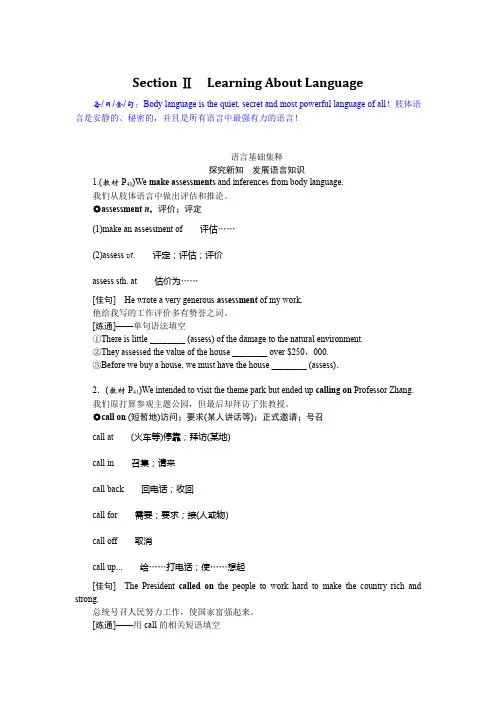
Section ⅡLearning About Language每/日/金/句:Body language is the quiet, secret and most powerful language of all!肢体语言是安静的、秘密的,并且是所有语言中最强有力的语言!语言基础集释探究新知发展语言知识1.(教材P40)We make assessments and inferences from body language.我们从肢体语言中做出评估和推论。
◎assessment n.评价;评定(1)make an assessment of 评估……(2)assess v t. 评定;评估;评价assess sth. at 估价为……[佳句]He wrote a very generous assessment of my work.他给我写的工作评价多有赞誉之词。
[练通]——单句语法填空①There is little ________ (assess) of the damage to the natural environment.②They assessed the value of the house ________ over $250,000.③Before we buy a house, we must have the house ________ (assess).2.(教材P41)We intended to visit the theme park but ended up calling on Professor Zhang.我们原打算参观主题公园,但最后却拜访了张教授。
◎call on (短暂地)访问;要求(某人讲话等);正式邀请;号召call at (火车等)停靠;拜访(某地)call in 召集;请来call back 回电话;收回call for 需要;要求;接(人或物)call off 取消call up... 给……打电话;使……想起[佳句]The President called on the people to work hard to make the country rich and strong.总统号召人民努力工作,使国家富强起来。
人教版高一英语必修四unit4 Body language教案Part 1.Teaching goals: 教学目标1. 语言能力目标●Talk about body language: cultural differences andimprove the students’ reading ability, such as skimming, scanning,get the detailed information and understand the main idea of the text.●让学生通过阅读,能够理解并尊重不同区域的人的身体语言和其文化涵义。
●进一步训练学生推测、略读、找读、归纳内容等阅读技巧;培养学生把握篇章中心内容、归纳段落大意、获取关键信息、并且能针对阅读内容表达自己的观点的能力。
3. 情感态度目标●要学生明白身势语是不同文化的载体,在跨文化交际中起到非常重要的作用,了解肢体语言在不同含义,可以帮助学生在日常的交际中正确的注意和使用自己的体态,姿势,面部表情等,正确的理解和运用肢体语言,达到良好的交际效果。
●Body language is actions that human beings canexpress themselves and communicate with otherswithout words, with which people can avoiddifficulties when they fully understand the bodylanguage when they communicate with others. Bodylanguage plays important roles in communicating.Part 2.Teaching Important and difficult Points●重点词汇与短语greet prediction represent association dormitory canteen flight curious curiouly Colombia approach cheek defend defence major misunderstanding Jordan dash adult spoken Spain Italy likely crossroadsdefend against be likely to in general●重点句子结构与用法Yesterday, another student and I, representing our university’s student association, went to …After half an hour of waiting for their flight to arrive, I saw several young people enter the waiting area looking around curiously.I stood for a minute watching them and then went to greet them.She stepped back appearing surprised and put up her hands, as if in defence.Then Akira Nagata from Japan came in smiling, together with Japanese student.When Darlene Coulon from France came dashing through the door, she recognized Tony Garcia’s smiling face.3.Improve the students’ reading ability, such as skimming, scanning,get the detailed information and understand the main idea of the text.4.let students learn about the words and expressions about body language.Part 2. Teaching Important Points:1.Teach the students how to understand body language used in different countries or cultures as well as in different occasions.2. How does body language differ among people fromdifferent cultures?Part 3. Teaching Difficult Points:1. Let the students know that there is both positive body language and negative body language.2.to grasp the main idea of the text.Part 4.Teaching Methods:。